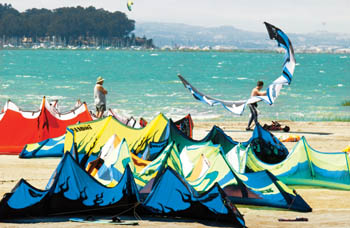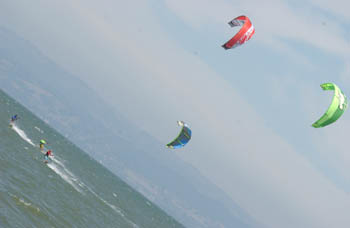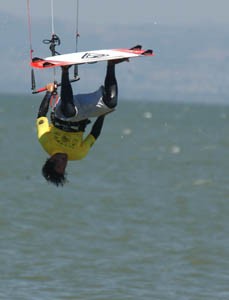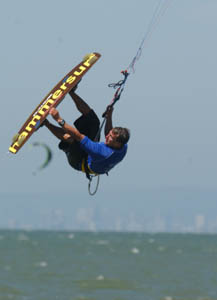![[Metroactive Features]](http://metroactive.com/features/gifs/feat468.gif)
[ Features Index | Silicon Valley | Metroactive Home | Archives ]
Out to Launch: Kites await riders along the tidal flats at Foster City's Third Avenue beach.
Jumping the Shark
Kiteboarding's growing popularity goes where the wind blows
By Traci Vogel
AS STEVE Gibson bobbed in the 6-foot chop of the Pacific Ocean, Mt. Tamalpais the only land visible, like a puff of smoke on the horizon, his own mantra slid into his waterlogged mind:
Sharks can't fly.
The words may have seemed, at the moment, a little pale. Gibson was in the midst of navigating the 28-mile stretch of water between the notoriously great white-infested Farallon Islands and San Francisco's Crissy Field, hooked to a 12-meter kite now downed and floating next to him. The board that had been strapped to his feet drifted in the water somewhere nearby, and his two companions, lofted by the wind, were fast becoming small dots above the churning whitecaps.
Worried faces peered from two nearby fishing boats. Worried voices shouted, "Do you want us to get your board?"
"No!" Gibson shouted back. He wanted to do this on his own. He and his companions, one of whom, Chris Wasson, is credited with introducing kiteboarding to the Bay Area in the sport's dark ages six years ago, had just completed the first-ever open-ocean launch from the waters off the Farallons. To do so, they had had to maneuver two boats with three giant kites and 27 meters of entangled lines strung between. To get help now would negate all that, and Gibson was damned if he'd let that happen.
It's not like he hadn't seen worse. Once, he'd had a kite rip open after he launched from Crissy Field, and it took him two hours to swim back in from the north tower of the Golden Gate Bridge. By the time he reached shore, it was dark.
Here, it was the middle of the day, and his companions were nearly invisible. Gibson flailed through the lumpy water, trying not to think about what toothy creatures swam beneath him, until he found his board. He strapped himself back on and flailed some more until his lines were clear and straight. Finally, the flapping lip of his kite caught air and sailed into the sky, taking Gibson with it. His mantra was vindicated:
Sharks can't fly. Kiteboarders can.
The Hook-Up
Two weekends ago, Aug. 13-15, a thousand spectators gathered at Third Avenue, a clay-limned stretch of beach hidden behind Foster City's industrial scrum, east of Highway 101. They came to watch the fourth-annual King of the Bay kiteboarding competition, a dogfight of speed, freestyling and huge kite loops.
Kiteboarding is one of those sports that exude a kind of raw natural appeal, like martial arts or skateboarding. Partly this is because it relies on a physical force of nature—the wind—and partly it's because the sport is elegant to watch. And although most experts credit two French brothers, Dominique and Bruno Legaignoux, with refining the technical aspects of kiteboarding to a point where it could begin its steep ascent in recent popularity, others also point to a much more American beginning.
Kiteboarding, it appears, was invented by none other than the indispensable Benjamin Franklin. Legend has it that one languid summer afternoon in the early 1700s a young Ben Franklin, "being desirous of amusing myself with my kite, and enjoying at the same time the pleasure of swimming," found himself and a plank he used for a float propelled across a "mile-broad" pond "without the least fatigue and the greatest pleasure imaginable." It was an activity he recommended, although the record fails to mention how many actually took him up on it.
In the 1980s, the Legaignoux brothers added an inflatable bladder to the leading edge of a C-shaped kite, and Ben Franklin's invention sped up tenfold.
But it's only been in the past two years, as technology has boosted safety and agility, that sales of kiteboarding kits have really boomed. The industry estimates that in 1998 it sold around 250 setups. In 2003, 70,000 kites flew off the shelves. Sports television covers kiteboarding events; there are no less than four magazines dedicated to the sport; and Democratic presidential candidate John Kerry regularly hooks himself up to a kite (in an interview with the Boston Globe, Kerry described kiteboarding as "a form of meditation").
Amid the kiteboarding frenzy, Northern California has held its own as a zone in which to float. Coyote Point, Alameda, Rio Vista, Crissy Field, Scott's Creek, Third Avenue, Santa Cruz and the reputedly "zoolike" Waddell Creek draw kiteboarders worldwide. In the past couple of years, Silicon Valley has birthed kiteboarding stars like Jeff Kafka, David Bingham, Rich Wilde, Jodi Taliaferro, Jaime Arndt, Joey Pasquali and Dana Pinto, the Santa Cruz-based winner of the 2002 King of the Bay competition. And, of course, Chip Wassen, Bay Area kiteboarding progenitor.
Regulars say it's easy to get hooked on kiteboarding's appeal—the thrill combines the speed of wakeboarding, the high of flight and the technical prowess of sailing. Most kiteboarders give a shorthand description of their sport as "like wakeboarding, but you're pulled by the kite instead of a boat." Kites, made of sailcloth nylon, span anywhere from 10 feet across to 15 feet and are given structure by an inflatable backbone out of which several small inflatable ribs project. They're steered via four lines attached to a control bar, which is then attached to the rider's harness. Riders bob along, buoyed by the kite aloft roughly 50 feet above, with a board strapped to their feet as a surfing platform, landing pad and ersatz shark shield.
The sport, with its intimations of Icarus' fall from grace, strikes many onlookers as dangerous and inaccessible, but kiteboarders routinely insist that a few lessons are all it takes to get anyone literally and figuratively hooked.
"It's incredibly fun," says Sarah Broome, co-owner of Rainbow Fin Company in Santa Cruz. Broome, who began kiteboarding when she took lessons on her honeymoon in Maui about four years ago, rates the sport about a 5 or a 6 on a 1-to-10 danger ratio. "People look at the danger factor of it and go, well, it's dangerous, and you're going to die. But you can get hurt doing anything. You can walk across the street and get hit by a random car. Yes, you're doing an extreme sport—you're not just sitting in your Barcalounger watching TV. But the numbers of people getting hurt are so small I think it's just not a factor."
In fact, only a handful of kiters have been killed or seriously injured in the sport's short history—but those incidents make for dramatic warning stories. And they make state and national park services nervous. Last year, when expert Peter Nordby died after a kiteboarding accident in Florida, Padre Island National Seashore park service officials banned the sport entirely. Kiteboarders fear the ban sets an unwelcome precedent.
Broome, like almost all kiteboarders, emphasizes that the sport is not one that participants can pick up on their own. "Someone getting into the sport definitely needs to get some lessons," she says.
Steve Gibson agrees. "Just like you wouldn't learn to parachute on your own, you wouldn't learn to kiteboard on your own," he says.
I decide to heed the kiteboarders' advice—and watch someone else get a lesson.
Bat Men
At 2pm on an August Friday, beneath a clear glass sky, a handful of red, blue and orange kites bloom on the gray-green waters of San Francisco Bay, while more wait like landed bats in the parking lot at Third Avenue.
Third Avenue seems an oddly lackluster name for a stretch of beach, but anything more picturesque would probably draw too many nonkiters to the already crowded parking lot behind Foster City's community golf course—so Third Avenue it is. I kill my car in front of a sign warning "Stray Golf Balls: Park at Your Own Risk" and head out to find Phil Sobolev, who teaches kiteboarding for one of the more popular sports stores in Silicon Valley, Palo Alto's Helm Sports of Sun Valley.
Phil, 32, emerges from a trailer-sized storage container at the end of the parking lot. A muscular well-tanned man, his scalp is so closely shaved and slicked with sunblock that it glistens like the waterproof pelt of a sea otter. This time of year, Phil gives between three to five lessons a week, depending on the weather. Lessons are divided into two parts: the land lesson and the water lesson. Today, he's giving a water lesson to a guy named Scott, who's already been practicing kite-steering techniques.
Before Scott arrives, Phil shows me a training kite, the smaller version that beginners master on dry land before graduating to the behemoth real kites. At about 3 feet across, the doctor's-mask-shaped kite looks like a toy, and in fact, Phil says there are those macho types who are disappointed by this less-than-dramatic entry into the extreme sport.
"A lot of guys think they don't need this," admits Phil. "That they'll spend $110 on it and never use it. But I tell them if they don't find this one of the most invaluable tools—not to mention fun—I'll give them a $50 refund." So far, he hasn't had to ante up.
Practice on the training kite gives people a sense of how wind direction fluctuates and of how the four steering lines make the kite move. Ideally, a newbie should be able to maneuver the training kite into figure eights by the time they get to the first lesson.
Phil's student Scott, when he shows up, proves familiar with the concepts—he's a lifelong sailor and, like most beginning kiteboarders, a longtime windsurfer—so he and Phil rig up with wetsuits and harnesses, and Phil demonstrates how to use a hand pump to inflate the bladder of the big kite. The ground next to the storage container is covered with scraps of old carpeting, so that kiteboarders and windsurfers can set up their gear in puncture-proof comfort.
Phil's goal with today's lesson, he emphasizes, is not to get Scott up on the board but to teach him how to launch the kite and then deal with all the possible things that can go wrong. Ninety-nine percent of kiteboarding accidents happen on launching or landing. Scott will learn how to set up the kite and lines, how to water-relaunch (get the kite back up in the air after it's fallen in the water) and how to self-rescue (get back to land if a line snaps or injuries occur).
The 7-foot Cabrinha-brand kite unfurls as its ribs inflate. By 2:30, the setup site is packed with fluttering kites alongside windsurf sails that litter the carpet like translucent dragonfly wings. The inevitable friendly dog, drunk with exercise, careers through the clutter. Third Avenue excels as a kiteboarding and windsurfing haven—and as a venue for King of the Bay—because of the relative shallowness of the bay here, which warms up the water a little, and the reputed steadiness of the thermal winds that barrel down San Francisco airport. Looking northwest, Candlestick Park hazes in the distance. To the southeast, Dumbarton Bridge arcs away, and airplanes drone low overhead at irregular intervals, sending larger sail-shaped shadows over scalloped bay waters.
Once the kite is inflated, Phil and Scott head out via the paved path for Third Avenue's upper launch area—a muddy spit dotted with sandbags, which are used to weight the kites before they're launched. We pass a guy in a "Howard Dean for America" T-shirt (which I take as evidence of the extreme sporter's nonfear of bluster) and two boys struggling with a training kite.
Phil stops to give the awestruck kids a couple of pointers, and then, once we're on the spit, he rummages for a driftwood stick with which to sketch out a diagram of wind direction in the mud. The kiteboarder wants to keep the kite at a 45-degree angle. Straight ahead, it's in the "cone," where the pull can be too strong to control. "The lower the kite, the more pull and less lift you get," explains Phil. "The higher the kite, more lift, less pull." All of this makes sense to Scott the sailor.
As if the kite were a rare giant jellyfish, Phil delicately untangles the rigging straight out along the mud flats. He guides the four color-coded strings between his legs to keep them separate and hooks them to the kite via a knot-and-loop system. With Phil on the end of the rigging, Scott flips the kite over, and it sails up like an obedient dog. Now the only thing anchoring the kite to earth, Phil strains against the rigging that blossoms from his midsection. The lift is evident in the pull on his body; suddenly he's buoyant. This is what ballet dancers aspire to look like: anti-gravity. Then Phil and Scott head for the water.
"Body-dragging" is the slightly morbid term for kiteboarding sans board. This is how kiters learn to move around in the water and how to gauge the kite's pull on their own weight. After Phil shows Scott how to work the rigging, he hooks Scott up and Scott suddenly adopts the anti-gravity stance. Then Scott goes limp in the water, and the kite takes over. Scott bobs like a fish on a line. He's got it.
Next: How to launch the kite from the water. By yanking the trapezelike bar at an angle, Phil forces the kite down. It descends hard, and when it hits the water there's a loud pop. Scott leans into the water, and when the kite lifts off it sheds skeins of water that glitter in the sun. Then Scott drops the kite, and Phil shows him how to turn it into his own personal sailboat, in case he ever gets injured and has to "sail" back to land. By pulling both ends of the kite together to form a loop, then lying on one of the ends, a kiter can form a miniature galley ship, the sail of which catches the wind and pulls him ashore.
It's 4:30 now, and I count 29 kites on the launching spot and in the bay. All around me, kiters in colorful skin-tight wetsuits leap into the air like superheroes. It seems a heroic—and terrifying—thing to do, tethering oneself to the wind. I'm beginning to understand the addiction.
Sweet Sensation
The psychology of the extreme sporter has become a Ph.D. dissertation favorite of late. Freud and his kin considered risk takers mentally ill, theorizing that those who engage in high-danger sports may be missing the basic evolutionary survival mechanism. But contemporary studies have shown that, on the contrary, risk takers tend to be more well-adjusted, self-confident types. Far from nurturing a death wish, risk takers' rush toward adrenaline merely reminds them that they're face to face with life. It's not that people who engage in extreme sports—sky diving, say, or mountain climbing—have no fear. Rather, to these people, fear is just another word for fun. Psychoanalysts have come up with a label for the set of risk-taking personality traits: "sensation seekers."
It's probably no coincidence that a preponderance of kiteboarders seem to hail from the technology world. The equipment and the novelty appeal to the gadget-prone, and plain old avoidance of boredom spurs a surprising amount of innovation around here. Eric Steinbroner, CFO of San Jose's Centerpoint Broadband Technologies, an optical networking company, was one of the pioneers of kiting. Gabe Brown, a web developer, was one of the founders of the San Francisco Kiteboarding Association. Then there's Steve Gibson—he works as a director of strategic development at Verisign, and runs a kiteboarding website, kiter.com.
Gibson describes himself as "just a regular kiter," despite his predilection for shark mantras. While he doubts that anyone will try the Farallon Islands crossing again—once it's been done, it's old hat—he's sure that innovative kiteboarders will continue to push the edge of sensation seeking. This year's King of the Bay winner, Aaron Hadlow, 16 years old, gives an indication that the sport may be moving toward big, acrobatic moves. In an interview on kiter.com, Hadlow says, "It's really about innovation, trying things that have never been done."
What's more, kiting innovation isn't limited to the water. "Kites are going to change everything," Gibson enthuses. "It's not just kiteboarding, but it's the kite as a power source. Guys are climbing mountains with kites now and are doing first ascents that have never been done before. They can pack the kite in a backpack, skate over ice bridges and get up to totally inaccessible locations. Kites open up a whole new realm in terms of exploring and in terms of sports—you can use the same kites that you use in the water on your snowboard or on your skis. I even do a lot of kite landboarding, where you can use this giant skateboard and get up to 30 miles an hour just like you would on the water. The beauty of kiting is that it combines all the action of land sports and water sports into one, and gives you this totally portable power source."
A future powered by kites? For now, the thrill and novelty of kiteboarding itself is probably enough for most people. But considering how quickly the sport is rising in popularity, anything is possible. Not even the sharks can stop it.
[ Silicon Valley | Metroactive Home | Archives ]
Copyright © Metro Publishing Inc. Metroactive is affiliated with the Boulevards Network.
For more information about the San Jose/Silicon Valley area, visit sanjose.com.
![]()

Photographs by Dave Lepori

Pull and Be Damned: Nylon kites can propel riders twice as fast as windsurfers with half as much wind.

Anti-Gravity: Chew on this: Democratic presidential candidate John Kerry calls kiteboarding "a form of meditation."

Blown Away: Up-and-coming kiterboarders say the sport's future lies in acrobatic moves.
Send a letter to the editor about this story to letters@metronews.com.
From the September 1-7, 2004 issue of Metro, Silicon Valley's Weekly Newspaper.